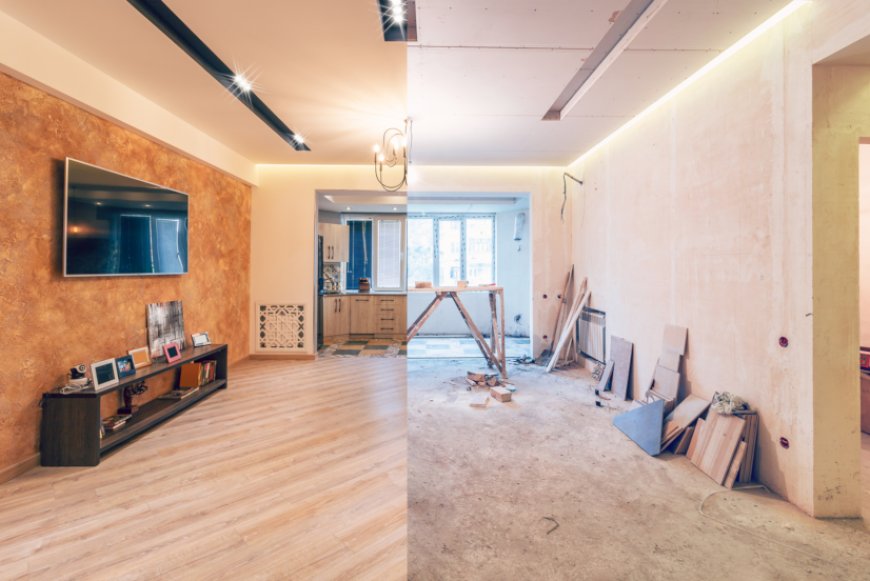What Informs Smart Home Renovations in 2025
Explore how modern home renovations are driven by health, energy efficiency, and changing lifestyles, based on research and real-world design trends.

The concept of "home" has evolved dramatically over the last few decades. Once considered a static, permanent structure, the home is now seen as a dynamic space—one that adapts to lifestyle shifts, environmental priorities, and technological advances. Renovation and remodelling are no longer reserved for luxury; they have become essential tools for functional adaptation, environmental efficiency, and psychological well-being.
The Shifting Role of Domestic Spaces
Our homes serve multiple purposes beyond shelter. They are workplaces, classrooms, wellness retreats, and social hubs. The COVID-19 pandemic was a pivotal moment in this shift, forcing people to reevaluate the function and form of their living spaces.
Recent studies conducted by the American Institute of Architects (AIA) and the UK’s Royal Institute of British Architects (RIBA) observed a spike in demand for adaptable spaces: home offices, multi-use rooms, and separate zones for rest and productivity. This need for flexible layouts has influenced floor plans, furniture design, and even lighting systems.
In short, the modern home must multitask, and successful renovation begins with understanding those new demands.
Health & Well-Being at the Forefront
Home environments have a direct impact on physical and mental health. The World Health Organization identifies indoor air quality, natural light, noise levels, and spatial arrangement as key determinants of wellness.
Key health-focused renovation trends include:
-
Air Quality Improvements: Ventilation systems, non-toxic materials (like low-VOC paints and formaldehyde-free cabinetry), and indoor plants can drastically improve air quality and reduce allergens.
-
Daylighting Strategies: Increasing window sizes, adding skylights, or using reflective materials helps maximise natural light, supporting circadian rhythms and boosting mood.
-
Acoustic Zoning: Acoustic insulation, soft materials, and spatial planning contribute to sound separation—essential for families working or learning from home.
-
Design for Mental Health: Clutter-free designs, calming colour palettes, and biophilic elements (wood, stone, water features) contribute to stress reduction and mental clarity.
Energy Efficiency & Sustainable Retrofits
Renovation is increasingly guided by sustainability goals, both for environmental responsibility and cost efficiency. Governments and environmental bodies now offer incentives for homeowners to reduce their carbon footprints.
According to research published in the Journal of Green Building, the following upgrades have shown measurable impact:
-
Insulation and Sealing: Retrofitting walls, roofs, and floors with high-performance insulation can reduce heating needs by up to 40%.
-
Window Upgrades: Replacing single-glazed windows with double or triple glazing improves thermal retention and reduces outside noise.
-
Smart Systems: Programmable thermostats, motion-sensitive lighting, and energy-monitoring systems give homeowners greater control and efficiency.
-
Solar Integration: While still dependent on location and roof design, photovoltaic (PV) panels offer long-term energy savings and may increase property value.
Sustainable design isn’t just about saving energy; it also enhances comfort and creates homes that are future-proofed against energy regulations and utility price volatility.
The Rise of Material Consciousness
Materials used in home renovation now come under heavier scrutiny. There’s a growing awareness of how material choices affect indoor air quality, environmental impact, and longevity.
Research from architectural journals and case studies suggests the following shifts:
-
Local Sourcing: Locally sourced materials reduce the carbon footprint associated with transportation and often blend better with the regional aesthetic.
-
Reclaimed and Recycled Materials: Salvaged wood, recycled tiles, and repurposed stone are becoming staples in eco-conscious homes.
-
Low-Impact Finishes: Natural oils, plant-based sealants, and mineral-based paints offer healthier alternatives to traditional chemical finishes.
-
Lifecycle Analysis (LCA): Professionals increasingly assess products based on extraction, manufacture, use, and disposal phases to choose options that are low-impact throughout their lifespan.
Material decisions now blend environmental and aesthetic logic, contributing to both sustainability and storytelling within the space.
Digital Tools & Smart Planning
Renovation planning has been transformed by digital technologies. Tools like Building Information Modelling (BIM), 3D visualisation, and AR walkthroughs allow homeowners to “experience” renovations before construction begins.
Research by McKinsey & Company highlights how digital tools reduce change orders, improve project timelines, and enhance client satisfaction.
Some benefits of digital renovation planning include:
-
Cost Forecasting: Software platforms can simulate material costs, labor, and contingency planning with real-time updates.
-
Precision Design: Laser scanning and digital measuring tools reduce human error and improve fit-out accuracy.
-
Scenario Testing: Virtual models can show how a space performs across lighting conditions, furniture layouts, and energy simulations.
Digital design bridges the gap between imagination and execution, reducing risk while allowing for more ambitious design goals.
Social Trends Driving Renovation
Beyond technical and health considerations, social changes also shape how homes are reimagined. Some notable trends include:
-
Multi-Generational Living: With housing costs rising, families are combining resources. Renovations now include separate living quarters, accessible bathrooms, and private entrances.
-
Remote Work: Home offices with soundproofing, natural light, and ergonomic design are now central to renovation plans.
-
Aging in Place: The global aging population is prompting renovations that include stair lifts, wider doorways, walk-in showers, and non-slip flooring.
-
DIY & Personalisation: A surge in self-led design and renovation projects has been documented across platforms like Pinterest and Houzz. Homeowners want to infuse personality into their spaces rather than follow trends.
Social shifts ensure that renovation is not one-size-fits-all—it’s deeply personal and responsive to life’s changes.
Regulations & Planning Requirements
A frequently overlooked but critical aspect of renovation is compliance. In the UK, for instance, renovations often require approval under Building Regulations, and in some cases, planning permission.
Areas that commonly require oversight include:
-
Structural Changes: Removing walls, adding extensions, or modifying load-bearing elements require structural calculations and inspections.
-
Electrical and Plumbing: Upgrades must meet safety standards under Part P of the Building Regulations (Electrical Safety) and Water Supply (Water Fittings) Regulations.
-
Listed Buildings and Conservation Areas: Homes in these categories are subject to strict controls over material use, external appearance, and permissible changes.
Homeowners benefit from understanding these regulations early in the planning process. Ignoring them can result in costly delays, fines, or even enforced reversals of completed work.
Measuring Value Beyond Resale
While resale value is a common motivation for renovation, many homeowners are now evaluating projects based on use-value and lifestyle enrichment. A well-renovated home can improve daily routines, reduce stress, support better relationships, and align with personal values.
A study by the Home Improvement Research Institute (HIRI) showed that the most satisfying renovations were those that:
-
Solved long-term lifestyle inefficiencies
-
Supported family growth or care
-
Enabled hobbies or wellness routines
-
Reflected the homeowner’s aesthetic identity
Thus, the return on investment is no longer purely financial—emotional and functional returns are just as important.
A Broader Understanding
Renovating a home is a multifaceted process, one that extends far beyond choosing tiles or paint colours. It involves rethinking how space serves daily life, accommodates changing needs, and contributes to long-term health and sustainability. Whether you are upgrading a post-war bungalow, retrofitting a Victorian terrace, or updating a suburban semi-detached, the principles of good renovation remain the same: thoughtful design, scientific understanding, and human-centred intent.
Professionals offering " Home Renovation & Remodelling Services " often bridge the gap between these principles and their practical execution, integrating research, regulation, and craftsmanship into cohesive, livable environments.
What's Your Reaction?
 Like
0
Like
0
 Dislike
0
Dislike
0
 Love
0
Love
0
 Funny
0
Funny
0
 Angry
0
Angry
0
 Sad
0
Sad
0
 Wow
0
Wow
0




































